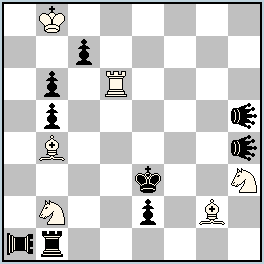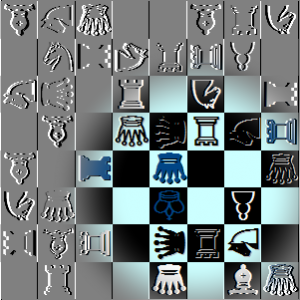|
|
Original Problems (page 69)Original fairy problems published during 2012 will participate in the informal tourney JF-2012. The site is mostly about fairies, but h# and s# are also welcomed for publication! Please send your problems to my e-mail: julia@juliasfairies.com Go to →List of Problems ; →Page 68 ; →Page 70 |
Today I’m happy to share with you my birthday’s gift. A very unusual one, something I’ve never had for my birthdays. I’m very grateful to my dear teacher, great composer, exceptional person – GM Petko A.Petkov – for the attention and for the fine problem!
No.128 – hs#2,5 by Petko A.Petkov – Interesting battery play with Double Grasshopper. (JV)
Definitions:
Grasshopper(G): Moves along Q-lines over another unit of either color to the square immediately beyond that unit. A capture may be made on arrival, but the hurdle is not affected.
Double Grasshopper(DG): Makes a Grasshopper move without capturing, then a 2nd Grasshopper move.
Lion(Li): Moves along Q-lines over another unit of either color to any square beyond that unit. A capture may be made on arrival, but the hurdle is not affected.
Rook-Lion(RL): Moves like Lion, but on Rook-lines only.
You can сlick on “Solutions” to show or hide the solutions!
|
No.128 Petko A.Petkov
Bulgaria
original – 16.09.2012
Dedicated to Julia Vysotska
on the occasion of her birthday  hs#2,5 2 solutions (6+9)
Double Grasshoppers: h4, h5
Rook-Lion a1
Solution: (click to show/hide)
|
The diagrams are made on WinChloe and its Echecs font is used for Logo design



Excellent! Another gem of a problem from Mr.Petkov !!
Many intricate pins, battery creations and battery openings. The avoidance of white defence Bb7 is another master touch !
I wish that in the first solution the DG move was to c2 (or c1) instead of to c4. In that case, the white sacrificing checks on c4 and c5 would have been perfect dual avoidance in both phases !! (However I cant see any easy way to do it !)
Happy Birthday, Julia!
Congratulations to the author GM Petko A.Petkov because He gave You a beautiful gift!
I hope that I will not be a spoilsport with this remark:
If Sb2 stands on b3, the stipulation is
hs#3 2 solutions (6+9)
I. 1.Sb3-c5 DGh4-c4 2.Sc5-a4 b5*a4 3.Bb4-c5 + b6*c5 #
II. 1.Sb3-d2 DGh5-c3 2.Bb4-a5 b6*a5 3.Sd2-c4 + b5*c4 #
With best wishes,
János
Janos. It is interesting that the shift of Sb2 to b3 introduces such a nice introductory move ! But Petkov may still prefer the existing setting, as in the diagram position white has the option of all his four moves and he has to choose the correct pair (dual avoidance with ref. to black first move).
Yes, Seetharaman, You’re right!
Obvious, The Author avoided the first moves of white intentionally!! The solvers can see the difference…
János
Nice use of the double-grasshoppers obstructing both the wR and wB in the final position. However, these effects are quite “accidential” as the “obstructing” units already stand on their squares in the beginning and nothing is done or avoided to achieve them.
Also, the effect that the rook-lion produces is accidential and it could easily be removed by moving the wBg2 to a8 and adding a wP on a7.
Hm…..Yes the white rook is already pinned in the diagram. But the avoidance of Bb7 happens during the solution by arrival of pawns on c4/c5.
Rook-lion is of course the oddman, but since the black pawns are anyway arriving on the a file, Petkov has used it for guarding WK.
“Accidental” and “artificail” effects may be differently considered by different people.
bRLa1 is not needed for the logic of this problem but it it enriches the mechanism through a bi-valve effect -> one part of the mechanism fulfils two functions in one move. A logician may consider it artificial but a mechanic may prefere the artistry and enrichment of the precise mechanism.
The author chooses what he likes. The others may analize the relation between the economy and the achieved content. Here, bRLa1 is relatively cheap investment to give a function to black a-Pawns in mate. The logic part is “artificial” but the effect achieved by the real play is “artistic”.
The pin of wRd6 is passive but respective activity of white Doublegrasshoppers justifies it enough as a technical tool with an “accidental” artistic effect.. But the main reason why wR is on d6 is the guard of bPc7. So, the squares c8/c7 are reciprocally guarded by white Doublegrasshoppers.
The guard of c7 could be achieved in various ways without pinned wR. The guard of c7 could be activated by White as in the rough example:
Stipulation Hs#3
Pieces
White Kb8 Rd7 Pg5 Ph5 Bb4 Pg3 Sb2 Bg2
Black Pc7 Pb6 Pb5 DGf5 DGh4 Ke3 Pe2 Pf2 RLa1 Rb1
1.h5-h6 DGf5-c3 2.Bb4-a5 b6*a5 3.Sb2-c4 + b5*c4#
1.g5-g6 DGh4-c4 2.Sb2-a4 b5*a4 3.Bb4-c5 + b6*c5 #